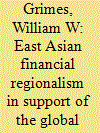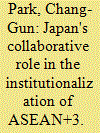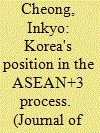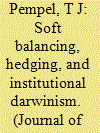|
|
|
Sort Order |
|
|
|
Items / Page
|
|
|
|
|
|
|
| Srl | Item |
| 1 |
ID:
140417


|
|
|
|
|
| Summary/Abstract |
Three decades of financial crises culminating in the global financial crisis have prompted the development of multilayered global financial governance. This article examines the relationship between the global and regional layers by analyzing the case of the global and ASEAN+3 financial safety nets. Making use of regime theory, we examine the evolution of the characteristics, main institutions, goals, and behavioral expectations of these two nets. The article argues that the ASEAN+3 regional financial safety net, which was mostly developed following the East Asian financial crisis of 1997, complements rather than undermines the global financial safety net. Similar characteristics, goals, and behavioral expectations underpin this complementarity.
|
|
|
|
|
|
|
|
|
|
|
|
|
|
|
|
| 2 |
ID:
075471


|
|
|
|
|
| Publication |
2006.
|
| Summary/Abstract |
East Asian financial regionalism has advanced significantly since the rejection of Japan 's Asian Monetary Fund proposal in 1997. Key ASEAN+3 initiatives include the Chiang Mai Initiative, which is designed to provide emergency liquidity to economies experiencing currency crisis, and the Asian Bond Market Initiative, which seeks to develop regional bond markets. Surprisingly, these initiatives-despite the assertive "regionalist" rhetoric that has surrounded them and their intellectual origins in the analysis of the 1997-1998 Asian financial crisis-are explicitly designed to complement existing features of the global financial architecture, including IMF conditionality and global financial standards. The nesting of East Asian financial regionalism within the global financial architecture results from the political-economic interests of the leading economies of the region. In the absence of a major change in the political-economic environment, nesting is a stable equilibrium and is unlikely to change.
|
|
|
|
|
|
|
|
|
|
|
|
|
|
|
|
| 3 |
ID:
156441


|
|
|
|
|
| Summary/Abstract |
Faced with the negative impact of regional and global financial crises, Asian countries have established joint-solution mechanisms over the last two decades in order to better protect themselves from short-term outflows of capital and from currency speculation. Despite some progress being made in regional financial cooperation, especially by the countries of the ASEAN+3 grouping, the overall degree of financial integration within the region remains surprisingly low, however. This contrasts sharply with the keen interest of many Asian countries in gaining a stronger voice within the multinational finance institutions (MFIs), and especially within the International Monetary Fund (IMF). Unable to initiate major governance reforms of the MFIs, Asian countries have not only set up regional support liquidity arrangements but also their own multilateral development banks (MDBs). While the USA and to some extent Japan have tried to prevent a rebalancing of power within the global financial architecture, major European countries have actively supported these changes by becoming founding members of the China-led Asian Infrastructure Investment Bank (AIIB). Taking a New Institutional Economics (NIE) perspective, the paper aims to explain why some regional financial institutions are more attractive for Asian countries than others and why European countries are supporting Asia’s attempt to gain more weight in global financial governance (GFG)—and, thus, contribute to the acceleration of the power shift away from the USA toward emerging Asian economies in general and China in particular.
|
|
|
|
|
|
|
|
|
|
|
|
|
|
|
|
| 4 |
ID:
086424


|
|
|
|
|
| Publication |
2009.
|
| Summary/Abstract |
The central framework of Asian integration is ASEAN+3 and, since its first Summit meeting in 1997, it has advanced regional integration in East Asia. Based on the direct experience of the author, this article presents a critical assessment of the progress made over the past ten years and argues that the 'Singapore Declaration' of 2007 is not ambitious enough for the future. An East Asian customs union (EACU) and common regional market should be the next targets for trade integration. In terms of monetary integration, Asia should aim for de-dollarisation and to achieve this it is crucially important to create a regional Asian monetary system (AMS).
|
|
|
|
|
|
|
|
|
|
|
|
|
|
|
|
| 5 |
ID:
111699


|
|
|
| 6 |
ID:
174653


|
|
|
|
|
| Summary/Abstract |
Since the 1997 Asian financial crisis, East Asia’s ASEAN+3 states have built the second-largest regional emergency liquidity fund in the world, the Chiang Mai Initiative Multilateralization (CMIM). With a total commitment of $ 240 billion to aid member states facing a currency crisis, CMIM can provide more funds to members than the International Monetary Fund (IMF). Nonetheless, CMIM continues to be functionally subordinate to IMF decisions. This may now be changing following the 2011 creation of the ASEAN+3 Macroeconomic Research Office (AMRO) as a regional mechanism to manage surveillance and design of CMIM lending programs. The ability to delegate surveillance and program design to an independent body is a crucial prerequisite to ending CMIM’s subordination to the IMF, and AMRO seeks to ensure such autonomy through its institutional design. This article analyzes AMRO’s progress toward autonomy, using indicators of effective delegation drawn from organizational theory and newly available information and data on AMRO.
|
|
|
|
|
|
|
|
|
|
|
|
|
|
|
|
| 7 |
ID:
059170


|
|
|
| 8 |
ID:
073565


|
|
|
|
|
| Publication |
2006.
|
| Summary/Abstract |
This article examines the significance of Japan's collaborative role in promoting regional integration in post-cold war East Asia, focusing on the institutionalization of the ASEAN+3 (the Association of Southeast Asian Nations+ China, Japan, and South Korea) from 1999 to 2005. This empirical case is essential to explain the main framework for the diffusion of regional institutionalization, which draws attention to Japan's collaborative role in the development of an effective institutional arrangement in East Asia. The ASEAN+3 process is the dominant engine for the formation of an East Asian Integration Regime (EAIR). Since the Joint Statement on East Asian Cooperation in 1999, Japan has taken advantage of changing circumstances to carve out a collaborative role in promoting the institutionalization of ASEAN+3. Seen in this light, the discussion seeks to explain Japan's regional projects in accordance with the rules and decision-making procedures of that group.
|
|
|
|
|
|
|
|
|
|
|
|
|
|
|
|
| 9 |
ID:
085916


|
|
|
|
|
| Publication |
2008.
|
| Summary/Abstract |
For sveral years after the financial crisis, Korea was Quite an active participant in the ASEAN+3 process, leading the discussion on East Asian economic cooperation through the proposals for the establishment of the East Asian Vision Group (EAVG) and the East Asian Study Group(EASG).
|
|
|
|
|
|
|
|
|
|
|
|
|
|
|
|
| 10 |
ID:
059171


|
|
|
| 11 |
ID:
096598


|
|
|
|
|
| Publication |
2010.
|
| Summary/Abstract |
East Asia has increased its formal institutional linkages in both the economic and security arenas. This article addresses three questions concerning this expansion. First, why has the number of institutions increased? Second, why is there so little overlap in the purposes and memberships of these many new bodies? Third, why have most regional institutions achieved such limited policy successes? The article demonstrates that the bulk of the new economic institutions represent collective responses to generalized pressures from globalized finance, whereas the new security bodies deal with regionally endogenous problems of a highly particularistic character. Furthermore, most regional bodies in East Asia still reflect the preeminence of individual state strategies rather than any collective predisposition toward multilateralism per se. East Asian regionalism thus represents a complex "ecosystem" of institutions whose future is likely to see the enhancement of some and the diminution of others through a process referred to here as "institutional Darwinism
|
|
|
|
|
|
|
|
|
|
|
|
|
|
|
|
|
|
|
|
|